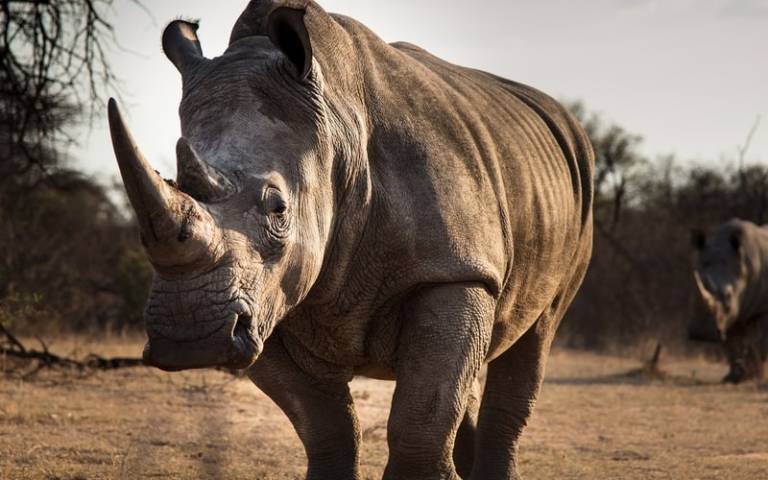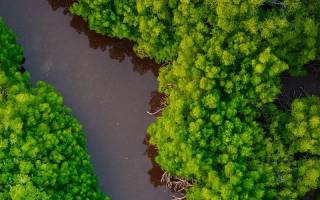Watch out for the Grey Rhino: The Connection Between Climate Change, Biodiversity Loss and Health
5 July 2021
In the wake of COVID-19, Jingwen Zhang (UCL Political Science) argues that we need to pay urgent attention to “Grey Rhino” events – obvious and yet widely ignored threats such as climate change and biodiversity loss which are escalating the risk of infectious disease outbreaks.

Jingwen Zhang is currently enrolled in the MSc International Public Policy at UCL. Her essay won a special prize (“Environmental Change and COVID-19”) in a GGI student essay competition on biodiversity and climate change.
In Field Notes from a Catastrophe, Elizabeth Kolbert (2006) says that, at the Hotel Arctic, people will feel the vastness of nature and the insignificance of man. Today, global warming is no longer a hypothesis. In 2019, the World Economic Forum concluded that climate change and biodiversity loss are among the greatest global risks facing humanity (WEF 2019). In recent years, large-scale infectious disease outbreaks have also been classified as high-risk global crises, and the combined impact of rapid environmental change and emerging health hazards could be devastating. So how can we best understand the relationships between the COVID-19 crisis, climate change, and biodiversity loss?
Black Swan or Grey Rhino?
COVID-19 is often considered a Black Swan event, an event with significant impact that took the world by surprise (Taleb 2007). Yet, behind the emergence of many Black Swan events, are Grey Rhino events, i.e. events with high probability and impact that could have been foreseen but were ignored (Wucker 2016). This includes climate change and biodiversity loss, two slow-moving but highly significant risks that increasingly affect human health and wellbeing.
It is the Grey Rhino event that we can prevent and protect ourselves against, as opposed to the Black Swan event that is impossible to anticipate. Yet, we neglect to take sufficient action in the face of Grey Rhino risks. Global warming has been widely recognised as a global problem. However, sea levels are rising, Antarctic glaciers are melting and coastal islands and cities are in jeopardy, ocean temperatures are rising, acidity is increasing, animal activity is extending towards the poles and biodiversity is under threat. Although, compared to Black Swans, Grey Rhinos are hard to miss, they can keep their footsteps very soft and stalk you so quietly that you forget to hide.
The Risk of Spill Over
Scholars suggest that the relationship between COVID-19, climate change and biodiversity decline may be interlinked at a deep level, requiring urgent attention (Lorentzen et al. 2020). As temperatures rise and rainfall patterns change, some species are forced to find new areas where they can tolerate the climatic conditions, while those that cannot adapt may face extinction. Climate change thus shapes the biogeographic distribution of species and affects biodiversity by forcing species to shift habitats, altering geographical ranges and bringing wildlife closer to humans. Consequently, species’ interactions increase the risk of cross-species transmission of viral diseases.
At the root cause of species migration and biodiversity loss is our disruptive interaction with the natural world, characterised by urbanisation, unsustainable economic development, and the shift of society towards environmental indifference. Almost any technological change inevitably disrupts ecological systems, and these stressors influence the infectious disease dynamics of the environment by altering the species composition of ecosystems in favour of species that transmit disease to humans more frequently, such as bats, rodents, and birds.
Climate change may also lead to the expansion or re-emergence of infectious diseases. By 2050, dengue fever could spread to the south-eastern United States as mosquito-borne areas expand from the tropics (Messina et al. 2019). Arctic heatwaves are melting the permafrost and could revive long-dormant pathogens such as the bacteria and viruses that caused anthrax, smallpox, or the 1918 flu pandemic (Dunne 2020). In addition, the prevalence of chronic diseases and the associated costs, are likely to increase. Longer and more severe fire seasons expose more people to smoke: the 2019 forest fires affected 80% of Australia’s population (Ward et al. 2020). Survivors may face an increased risk of cancer, respiratory disease and heart disease, with medical costs accounting for more than half of the total cost of the fires.
Environmental change and extreme weather events damage health directly, but also indirectly given their impact on infrastructures and socio-economic systems. For example, more frequent and intense storms can cause more injuries, but they can also increase mortality by disrupting emergency services and essential health care.
Off-track Reality and Future Outlook
Mankind is gradually pushing the planet on an uncharted course of development. As we adapt to changing conditions, the problems we face also change like moving goalposts in a ball game. This means that accepted theories, frameworks and tools may become useless, requiring the start of a whole new game with completely new rules. In the meantime, as species are changing their distribution, the distribution of pests and pathogens will change as well, with significant consequences for human health.
We are not the first species to change the atmosphere – that distinction belongs to the bacteria that first started photosynthesis billions of years ago (Warke 2020) – but we are the first to be able to think about our behaviour. Paul Crutzen (2002) introduced the concept of the “Anthropocene” as a replacement for the “Holocene.” But in this new era, human beings are still not sure where the goalposts are. Given the lag between emissions and consequences, the right response today is to make rapid changes to avoid more drastic and costly changes in the future and decrease the health risks of climate change.
The global public health crisis caused by COVID-19 compels us to fundamentally rethink our relationship with other living things and the natural ecosystems they inhabit. There is scope for stakeholders from all sectors to reduce their carbon footprint and protect biodiversity. Health sector suppliers can shift to renewable energy and low-carbon technologies, consumers can choose sustainable products and service providers, and policymakers can promote climate mitigation and adaptation efforts and direct investments towards green assets. Policy actions to protect biodiversity, address climate change, and improve the quality of the environment should be an integral part of all efforts to improve people’s livelihoods, promote employment and support the economy, safeguard health, and maintain national security, with a view to achieving synergies and promoting high-quality sustainable development.
References:
Crutzen, P. J. (2002). Geology of mankind. Nature, 415, 23.
Dunne, D. (2020). Q&A: Could climate change and biodiversity loss raise the risk of pandemics? Carbon Brief, 15 May 2020 [online]. Available at: https://www.carbonbrief.org/q-and-a-could-climate-change-and-biodiversit....
Kolbert, E. (2006). Field Notes from a Catastrophe: Man, Nature, and Climate Change. New York, NY: Bloomsbury.
Lorentzen, H. F., Benfield, T., Stisen, S. and Rahbek, C. (2020). COVID-19 is possibly a consequence of the anthropogenic biodiversity crisis and climate changes. Danish Medical Journal, 67 (5), A205025, 05.2020.
Messina, J. P., Brady, O. J., Golding, N., Kraemer, M. U. G., Wint, G. R. W., Ray, S. E., Pigott, D. M. et al (2019). The current and future global distribution and population at risk of dengue. Nature Microbiology, 4, pp. 1508-1515.
Taleb, N. N. (2007). The Black Swan: The Impact of the Highly Improbable. New York: Random House.
Ward, M., Tulloch, A. I. T., Radford, J. Q., Williams, B. A., Reside, A. E., Macdonald, S. L., Mayfield, H. J. et al (2020). Impact of 2019–2020 mega-fires on Australian fauna habitat. Nature Ecology & Evolution, 4, pp. 1321-1326.
Warke, M. (2020). Billions of years ago, the rise of oxygen in Earth’s atmosphere caused a worldwide deep freeze. The Conversation, 2 June 2020 [online]. Available at: https://theconversation.com/billions-of-years-ago-the-rise-of-oxygen-in-....
WEF (2019). The Global Risks Report 2019. World Economic Forum [online]. Available at: http://www3.weforum.org/docs/WEF_Global_Risks_Report_2019.pdf.
Wucker, M. (2016). The Gray Rhino: How to Recognize and Act on the Obvious Dangers We Ignore. New York: St. Martin’s Press.
 Close
Close


